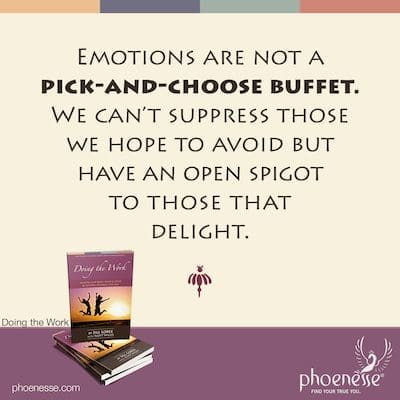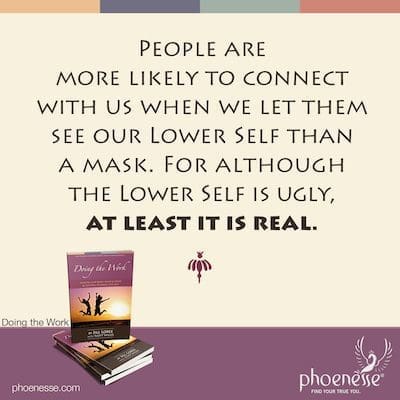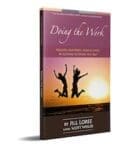My Favorite F-Word

According to the Pathwork Guide, Emotional Reactions are our seemingly hardwired responses to the ills of the world that cause us angst. We can identify Emotional Reactions by their tendency to carry a greater charge than the offending situation would logically illicit. Often, in fact, it can help just to maintain the perspective that “It could be possible for someone else—certainly not me, but somebody else—to be exposed to the same treatment and not be so bothered by it”. So maybe then, our feelings aren’t ironclad facts.
With a long history of intentional—albeit unconscious—numbing behind us, many of us find ourselves opening up into emotions that confuse and disorient us. As we thaw, we start to have feelings we don’t like and are at a loss to control. For immature feelings don’t come tumbling out in tidy little packages. No, the work of feeling our feelings starts out as messy, noisy business, and only much later becomes a bit more buttoned up, while nonetheless always tending to lean in the direction of untidy.
Consider that humanity gives a lot of rope and margin to the processes of growing up mentally and physically. No one expects college-level work from a fifth grader, and most varsity athletes in high school have been developing muscles and skills since they were in middle school, if not earlier. We have patience for the work that we must do, realizing expertise can only develop with time, effort and perseverance.
But when it comes to our feelings, we want our tears to be timely and our expressions of pain to make perfect sense and make us look good. But we are kidding ourselves. Emotions will need some time and attention before they are anything but unwieldy, if not downright ugly. Even expressions of joy and happiness may take some getting used to. For emotions are not a pick-and-choose buffet. We can’t suppress those we hope to avoid but have an open spigot to those that delight.
We all have frozen feelings to some extent. This is due to the script we agree to follow when we elect to become human. So we’re going to need to slowly warm ourselves back up to room temperature. Like submerging freezing-cold fingers into a pan of lukewarm water, there will be an ache that naturally accompanies this process.
To wit, our first attempts to express our feelings, if done directly to others who have wronged us, are apt to exacerbate the situation instead of improve it. This happens for several reasons. First, we tend to co-mingle our feelings with the distorted beliefs wrapped up in them. This makes us spew angry and violent words at those who apparently validate our conclusions about an unfair, unkind world. Second, since we don’t yet know how to take responsibility for our own feelings, we often proceed by blaming others for making us feel this way. Third, the cruel tendencies of our Lower Self will attempt to hurt the other in retaliation for the pain they have inflicted on us. And so the wheel goes round and round.
This is a principle reason for doing our healing work under the tutelage of a trained healer—a Pathwork Helper, therapist, spiritual counselor, or the like—who can help us access and express what is currently inside us. In this way, we make space for something new—new wisdom, new perspective, new compassion, new courage—to be born in us. Once we shift our relationship to our own inner wounds, we will be able to circle back to the people we feel “have done us wrong,” bringing new awareness for how to go about shifting our relationship with them. We’ll be able to move toward connection, instead of further separation. As it stands, our frozen inner blocks also obstruct our inner light that is always ready to guide us in navigating the unavoidable thorny patches of life.

If we’re attuned to the voice of spiritual seekers everywhere, we’ve likely heard the mantra that there is only one force in the universe, and that is love. While true that at the core of our beings we are indeed deep wells of never-ending love, the temporary truth of what lies on the surface of our beings—crusting over our Higher Self—is anything-but-love. We all have pockets of hate and spite, stashes of greed and envy, hidden corners of anger and rage. If we don’t know this to be true about ourselves, we haven’t yet scratched the surface in doing our inner work. And since non-loving feelings are what is present now, that’s what we must attend to. To look the other way is to continue blundering our way down an unlit path wearing a mask of defendedness.
When we’re in an Emotional Reaction, the reason that what happens around us bothers us is never the offending thing itself. The problem is that they pluck the strings of old, still-raw wounds. And they are now singing out tunes of their own. In such a situation, one of those split-off aspects of our beings has come to life. For it is starting to relive the pain and anxiety connected to a previous life experience the young child couldn’t handle. Subsequently, in the blink of an eye, we go into a self-selected reaction: we freeze, we fight or we flee.
When this happens, our work starts by bringing reason to our emotions, recognizing there must be a mistaken belief we are not yet aware of buried deep inside us. Ah ha! I must not be in truth. But this same split-off aspect is not in a position to find its way out of the darkness it’s now lost in. And so it is the ego that needs to wake up and recognize what’s going on. The ego must pause, take a breath, and begin to open that doorway to the Higher Self. For the Higher Self holds vast, loving wisdom, and is just waiting for us to tap into it. The ego must remember to pray.

The soul of every human being is comprised of three fundamental layers: the Higher Self, Lower Self and Mask Self. (See more details in Spilling the Script.) We’d all like to think we are beaming beacons of Higher Self light, and indeed, sometimes this is true; we all have areas in our lives where our finest qualities shine through into the world. And if that were the end of it, we wouldn’t need to come here. Alas, we’ve each also got Lower Self energies in need of transformation, and these are notorious light-blockers.
The Lower Self is a highly charged aspect of our beings made up entirely of twisted Higher-Self currents. There is not a single fault that can’t be unwound to reveal its original glorious face. But in its low-frequency Lower-Self state, it’s not a thing of beauty. Just below the surface of our conscious mind, we are keenly aware of this.
We know that if our negative tendencies are seen, we may not be well liked, much less loved. So here’s what we do: we develop a strategy to cover up our Lower Self with a mask. We then use this mask both to defend ourselves from pain and to always try to get our way, which we equate with love and happiness.
One might think there are an infinite variety of masks to choose from; in fact there are only three: Power Mask, Love Mask and Serenity Mask. It’s worthwhile getting to know which has become our favorite go-to mask, or defense. In fact, we may use one mask in one area of our life and another in a different area, all depending on which we think is apt to be most successful. (See more detailed explanations of our masks in Spilling the Script.)
There are two important things to note about the mask. First off, our mask is not real. What do we mean by this? It’s simply a strategy for keeping us safe and avoiding the pain of not getting our way. But that’s all it is: a strategy. And in the end, the mask is completely ineffective at doing its job.
Because no one buys the mask. Others can tell when we are not being genuine, and people don’t like to feel manipulated. So time-and-time again, our mask will trigger a bad reaction from others. Meaning, this false solution doesn’t bring us love, and instead it creates pain, which is the thing it is supposed to avoid.
The second thing to realize is that if we want to do any serious transformational work, we’re going to have to get at our Lower Self; we’re going to have to risk becoming more real. But as long as we believe our mask actually works, we won’t have the necessary impetus to make such a move. We must come to understand how and why we constructed our mask, so we can start to set it aside. It may be a comfortable habit, but it’s truly not helpful.
Note of caution: this doesn’t mean we can go around ripping off other people’s masks in an attempt to “help them out” by making them get more real. The psyche can experience quite a shattering if this work is not done intentionally and somewhat methodically. We need to bring reason to the young inner parts of ourselves still clinging to the idea that staying defended is a good strategy for staying safe.
We must come to see how we are the ones provoking others’ Lower Self, or at least encouraging them to also stay in their mask, when we present them with our Mask Self. Truth is, people are often more likely to connect with us when we let them see our Lower Self than when we are inauthentic and defended.
For although the Lower Self is hard to take, at least it is real.
In Jill’s Experience
We each have a different personal favorite way of responding when our feelings get hurt. Some will rise up in rage and try to control their world through manipulation. Some will suck up to others and attempt to cover the world with their “niceness.” Some will check out, finding a favorite way to be in the world and not here at the same time. Me, I run.
My tendency to run surfaces in my relationship with Scott when something happens that I see through the lens of “he doesn’t care about me,” or “I didn’t make the cut.” Note, there doesn’t need to be any truth to this at all for some young split-off aspect of me to strap on her shoes and take off. By the time I realize my nose is out of joint, parts of me can already be in another county. In those immature parts of me, I’m not yet able to tolerate the intensity of some old pain.
This is when I literally need to sit and hold these hurting parts of myself, actively asking my Higher Self to be present in the moment. I need to release the pain she is carrying, hear what untruth she is holding, and re-educate her with the wisdom that flows from my inner connection with the divine.
We might think, “Our Higher Self is always there, so why must we invite it in?” Because our work is to open the doorway, to actively want to connect with God within. That’s what makes doing this work of getting to know the self spiritual. Even though God has been with us this whole time—our Higher Self is made from the essence of God—I must remember to knock and ask God to come in.
In Scott’s Experience
In our lives, both as a couple and as individuals, I am noticing that Jill and I are more and more able to stay fully present with each other and life. The years of doing the work really do pay off in the end. Life and relationship just plain feel better being present, because another way to describe being present is being vibrantly alive. But we also trip up now and again, having to recognize where we’ve “gone”, work with that, and move back to presence.
My tendency has been to simply check out. I’m still here in a way, but also not here. I’ve closed off access, raised the bridge from the moat, so to speak. It was a way to deal with the frightening situations in life as a little kid, and later as a teen. I had aggressive hostility thrown my way, and rather than stand up and fight it, I simply checked out and went another direction wherever possible. As with Jill, I literally have to pause sometimes and hold this young kid in me. It was useful growing up, I guess, but like all pseudo-solutions it has been problematic as an adult.
Jill’s running and my checking out are just ways the little kid inside tried to stay safe from what it perceived as dangerous situations growing up. These patterns are especially difficult to deal with when we become adults in relationship though, because they form almost an autonomic emotional nervous system. Until we recognized it, Jill and I would ping back and forth to the point where, without knowing it, we ended up in different emotional zip codes.
Doing the work has allowed me to address my tendency to isolate, and to put a minute gap of space between trigger and reaction so I can shift out of it before I’m too far in it. I’m also more able to recognize the general patterns happening between people in teams I lead in my corporate life. These public spaces become much easier to navigate when we can see through the patterns.
Next Chapter
Return to Doing the Work Contents


